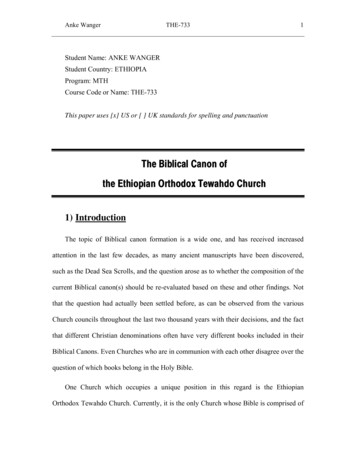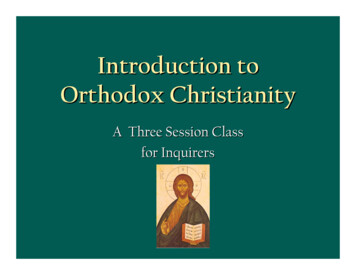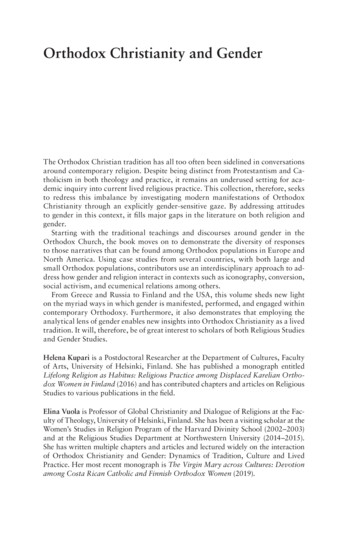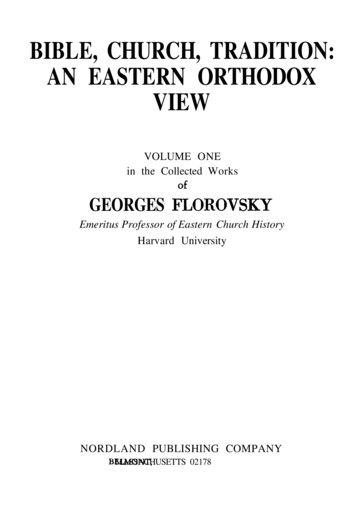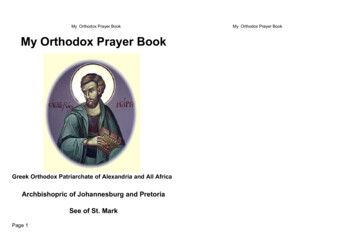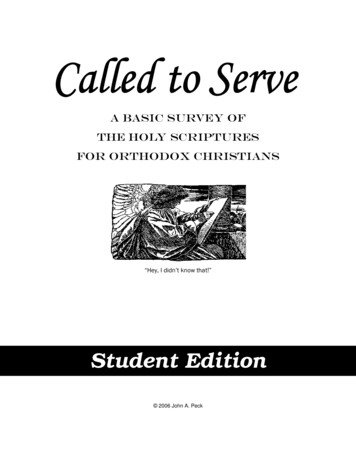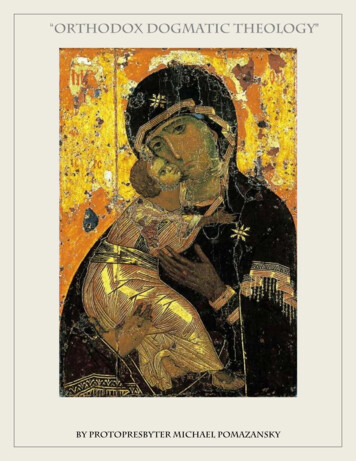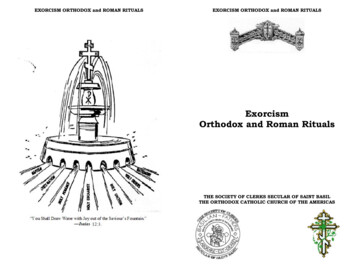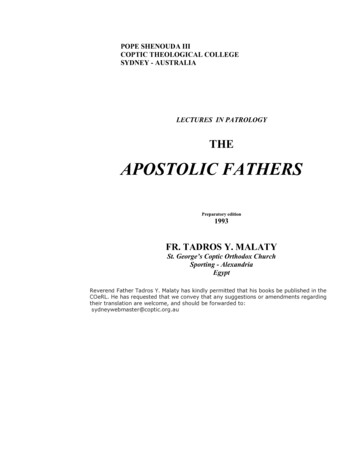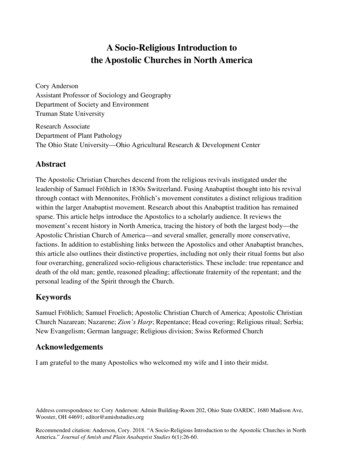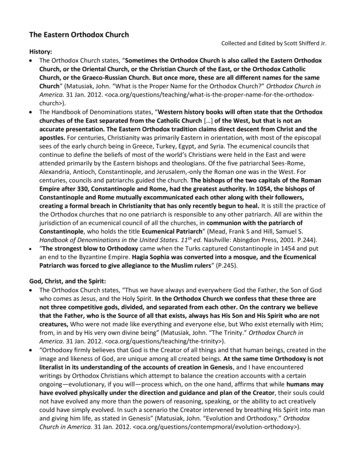
Transcription
The Eastern Orthodox ChurchCollected and Edited by Scott Shifferd Jr.History: The Orthodox Church states, “Sometimes the Orthodox Church is also called the Eastern OrthodoxChurch, or the Oriental Church, or the Christian Church of the East, or the Orthodox CatholicChurch, or the Graeco-Russian Church. But once more, these are all different names for the sameChurch” (Matusiak, John. “What is the Proper Name for the Orthodox Church?” Orthodox Church inAmerica. 31 Jan. 2012. -for-the-orthodoxchurch ). The Handbook of Denominations states, “Western history books will often state that the Orthodoxchurches of the East separated from the Catholic Church [ ] of the West, but that is not anaccurate presentation. The Eastern Orthodox tradition claims direct descent from Christ and theapostles. For centuries, Christianity was primarily Eastern in orientation, with most of the episcopalsees of the early church being in Greece, Turkey, Egypt, and Syria. The ecumenical councils thatcontinue to define the beliefs of most of the world’s Christians were held in the East and wereattended primarily by the Eastern bishops and theologians. Of the five patriarchal Sees-Rome,Alexandria, Antioch, Constantinople, and Jerusalem,-only the Roman one was in the West. Forcenturies, councils and patriarchs guided the church. The bishops of the two capitals of the RomanEmpire after 330, Constantinople and Rome, had the greatest authority. In 1054, the bishops ofConstantinople and Rome mutually excommunicated each other along with their followers,creating a formal breach in Christianity that has only recently begun to heal. It is still the practice ofthe Orthodox churches that no one patriarch is responsible to any other patriarch. All are within thejurisdiction of an ecumenical council of all the churches, in communion with the patriarch ofConstantinople, who holds the title Ecumenical Patriarch” (Mead, Frank S and Hill, Samuel S.Handbook of Denominations in the United States. 11th ed. Nashville: Abingdon Press, 2001. P.244). “The strongest blow to Orthodoxy came when the Turks captured Constantinople in 1454 and putan end to the Byzantine Empire. Hagia Sophia was converted into a mosque, and the EcumenicalPatriarch was forced to give allegiance to the Muslim rulers” (P.245).God, Christ, and the Spirit: The Orthodox Church states, “Thus we have always and everywhere God the Father, the Son of Godwho comes as Jesus, and the Holy Spirit. In the Orthodox Church we confess that these three arenot three competitive gods, divided, and separated from each other. On the contrary we believethat the Father, who is the Source of all that exists, always has His Son and His Spirit who are notcreatures, Who were not made like everything and everyone else, but Who exist eternally with Him;from, in and by His very own divine being” (Matusiak, John. “The Trinity.” Orthodox Church inAmerica. 31 Jan. 2012. oca.org/questions/teaching/the-trinity ). “Orthodoxy firmly believes that God is the Creator of all things and that human beings, created in theimage and likeness of God, are unique among all created beings. At the same time Orthodoxy is notliteralist in its understanding of the accounts of creation in Genesis, and I have encounteredwritings by Orthodox Christians which attempt to balance the creation accounts with a certainongoing—evolutionary, if you will—process which, on the one hand, affirms that while humans mayhave evolved physically under the direction and guidance and plan of the Creator, their souls couldnot have evolved any more than the powers of reasoning, speaking, or the ability to act creativelycould have simply evolved. In such a scenario the Creator intervened by breathing His Spirit into manand giving him life, as stated in Genesis” (Matusiak, John. “Evolution and Orthodoxy.” OrthodoxChurch in America. 31 Jan. 2012. oca.org/questions/contempmoral/evolution-orthodoxy ).
2Scriptures: God: Gen. 1:1-2, Psa. 110:1, Isa. 9:6, Mic. 5:2, John 1:1, 14; Creation: Gen. 1:26-27, Exo.20:11, Matt. 19:4-5, Mark 10:6-8, Luke 11:50-51, Rom. 1:20.Christ’s Words and the Scriptures: The Orthodox church says, “Since it is divinely inspired, the Bible possesses a fundamental unity, atotal coherence, because the same Spirit speaks on every page. We do not refer to it as ‘the books’ inthe plural, ta biblia. We call it ‘the Bible,’ ‘the Book,’ in the singular. It is one book, one HolyScripture, with the same message throughout one composite and yet a single story from Genesis toRevelation” (Matusiak, John. “How to Read the Bible.” Orthodox Church in America. 1 Feb. 2012. oca.org/scripture/how-to-read-the-bible ). “The interdependence of Church and Bible is evident in at least two ways. First, we receive Scripturethrough and in the Church. The Church tells us what is Scripture. In the first three centuries ofChristian history, a lengthy process of sifting and testing was needed in order to distinguishbetween that which is authentically ‘canonical’ Scripture, bearing authoritative witness to Christ’sperson and message, and that which is ‘apocryphal,’ useful perhaps for teaching, but not anormative source of doctrine. Thus, the Church has decided which books form the Canon of theNew Testament. [ ] Secondly, we interpret Scripture through and in the Church. If it is the Churchthat tells us what is Scripture, equally it is the Church that tells us how Scripture is to beunderstood” (“How to Read the Bible.” Orthodox Church in America. 1 Feb. 2012. oca.org/scripture/how-to-read-the-bible ). Accepting the Nicene Creed, “We believe in one God, the Father Almighty, Maker of heaven andearth, and of all things visible and invisible. And in one Lord Jesus Christ, the Son of God, the onlybegotten, begotten of the Father before all ages. Light of Light; true God of true God; begotten, notmade; of one essence with the Father, by whom all things were made; who for us men and for oursalvation came down from heaven, and was incarnate of the Holy Spirit and the Virgin Mary, andbecame man. And He was crucified for us under Pontius Pilate, and suffered, and was buried. Andthe third day He rose again, according to the Scriptures; and ascended into heaven, and sits at theright hand of the Father; and He shall come again with glory to judge the living and the dead; whoseKingdom shall have no end” (“Nicene Creed.” Orthodox Church in America. 1 Feb. 2012. acraments/nicene-creed ).Scriptures: Luke 1:1-3, Eph. 3:3-5, 2 Thess. 2:15, 2 Tim. 3:16-17 (cf. 1 Tim. 5:18), 2 Pet. 1:16-21, 3:15-16,1 John 1:1-4.Way of Salvation: The Orthodox church says, “There is no ‘required amount’ of works that are necessary forsalvation. What is crucial is that, if we indeed have faith that Jesus Christ is the Son of the LivingGod, Who came into the world to save sinners, that we manifest or reveal our faith in how we liveand how we treat others” (“Grace and Salvation.” Orthodox Church in America. 1 Feb. 2012. oca.org/questions/teaching/grace-and-salvation ). The Handbook of Denominations states, “The Nicene Creed in its original form is central to theOrthodox faith in all its branches. It is recited whenever the Divine Liturgy is celebrated and is theheart of the Orthodox theology and mysticism. Since for the Eastern churches a creed is ‘an adoringconfession of the church engaged in worship,’ its faith is expressed more fully in its liturgy than in adoctrinal statement” (P.246). The Orthodox church says, “Baptism in the Church begins with the rejection of Satan and theacceptance of Christ. Before being baptized, a person—or his sponsors or godparents for him—officially proclaims the symbol of Christian faith, the Creed. Because the godparent speaks on
3 behalf of the child, sponsors his entrance into the Church and ‘receives’ the child out of thebaptismal waters into the Church and cares for his spiritual life, the godparent himself must be amember of the Church.”“After the proclamation of faith, the baptismal water is prayed over and blessed as the sign of thegoodness of God’s creation. The person to be baptized is also prayed over and blessed withsanctified oil as the sign that his creation by God is holy and good. And then, after the solemnproclamation of ‘Alleluia’ (God be praised), the person is immersed three times in the water in thename of the Father, the Son and the Holy Spirit.”“Through the act of immersion, the baptized person dies to this world and is born again in theresurrection of Christ into eternal life. He is clothed with the ‘garments of salvation’ symbolized bythe white baptismal robe which is the ‘new humanity’ of Jesus himself who is the new andheavenly Adam (See Jn 3, Rom 5, 1 Cor 15). Thus, the words of the Apostle Paul are chanted as thenewly-baptized is led in procession around the baptismal font three times as the symbol of hisprocession to the Kingdom of God and his entrance into eternal life: ‘For as many as have beenbaptized into Christ have put on Christ. Alleluia’ (Gal 3:27).”“In ancient times this procession was made from the baptistery to the church where the newlybaptized received Holy Communion at the celebration of the Divine Liturgy” (“The Sacraments:Baptism.” Orthodox Church in America. 1 Feb. 2012. church/baptism ).“The unity for which Christ prays is no mere ‘quality’ of our life in Christ – but is our life in Christ.That this unity (communion) is the very life of salvation is made clear in St. John’s first epistle:[ ](1 John 1:5-7). Here our communion with God is described as a communion of light - though thenature of that light is made clear: God is light. St. John uses light to say that our communion is a trueparticipation in God, in His very life. This same saving participation in the life of God is presented inChrist’s discourse on the Eucharist:[ ] (John 6:53-57).[ ] This becomes particularly clear whenprayer is understood to be communion [koinonia] with God. And it is not prayer alone of which thiscan be said: the whole of the Christian life – every sacrament of the Church – has as its foundationour saving participation in the life of God.” (Freeman, Stephen. “Communion as Salvation.”Orthodox Church in America. 1 Feb. 2012. assalvation ).“Entering into the ‘Holy Communion’ of the Orthodox Church through baptism and chrismation,one lives according to the life of the Church in every possible way. One is first of all faithful to thedoctrine and discipline of the Church by faithful communion with the hierarchy of the Church whoare those members of the Body sacramentally responsible for the teachings and practices of theChurch; the sacramental images of the Church’s identity and continuity in all places and all times.When one enters into the community of marriage, a union of one man and one woman foreveraccording to the teaching of Jesus Christ, this union is sanctified and made eternal and divine in thesacramental mystery of matrimony in the Church. When one is sick and suffering, he ‘calls for thepriests of the Church’ to ‘pray over him, anointing him with oil’ in the sacramental mystery of holyunction (cf. Jas 5:4). When one sins and falls away from the life of the Church, one returns to the‘Holy Communion’ of the divine community by the sacramental mystery of confession andrepentance. And when one dies, he is returned to his Creator in the midst of the Church, with theprayers and intercessions of the faithful brothers and sisters in Christ and the Spirit. Thus the entirelife of the person is lived in and with the Church as the life of fullness and newness in God Himself,the Church which is the mystical presence of God’s Kingdom which is not of this world” (Matusiak,John. “Sacraments.”Orthodox Church in America. 1 Feb. 2012. ymbol-of-faith/sacraments ).
4Scriptures: Matt. 28:19-20, Mark 16:16, John 6:53-56, Acts 2:28, 3:19, 22:16, Rom. 6:3-7, 1 Pet. 3:21, 1John 1:5-2:6.Church and Church Government: The Handbook of Denominations states, “With more than 200 million members around the world,the Orthodox churches represent one of the three major branches of Christianity (the others beingRoman Catholic and Protestant). Unlike the Roman Catholic Church [ ], the Orthodox churches (alsoknown as the Eastern or Eastern Orthodox churches) do not have single hierarchical institution.Instead there are dozens of national bodies, each of which worships in its native language with itsown independent (autocephalous) hierarchy. Each Orthodox church thus reflects its own nationalheritage and ethnic customs in its liturgy. Unlike the Protestant churches, which also demonstrate awide variety of institutions and forms, most of the Orthodox churches are in communion with oneanother and hold to the same basic theology based on the ancient creeds of Christianity” (P.243). “The government of all Orthodox churches is Episcopal and hierarchical to a degree. There isusually a synod of bishops over which an elected archbishop, metropolitan, and patriarch presides. Inthe U.S., each jurisdiction is incorporated, with a church assembly of bishops, clergy, and laity [ ]Candidates for the deaconate and priesthood may marry before ordination but a forbidden tomarry thereafter” (P.247). The Orthodox Church states, “Concerning whether Roman Catholicism is considered a heresy:Orthodox Christianity in general would view certain aspects of Roman Catholic teaching asheretical. [ ] Orthodox Christianity also rejects such teachings as the Immaculate Conception,purgatory, and other uniquely Roman Catholic doctrines” (“Validity of Roman Catholic Orders.”Orthodox Church in America. 1 Feb. 2012 ancatholic-orders ). “I can state, however, that the Orthodox view and attitude of the Roman Papacy is not a matter ofrefusing to accept the authority of the Pope but, rather, a matter of historic reality. The bottomline is that, during its 2000 year existence, the Orthodox Church had not been subject to theadministrative authority of the Pope of Rome, and this is borne out in the extant decrees of theearly Church councils. These councils, while acknowledging the Pope as the ‘first among equals,’ inno way envision the Bishop of Rome’s ‘primacy of honor’ as a ‘supremacy of jurisdiction.’ The papalclaims to supremacy are of much later origin, and there are many who would argue that such claimshave done far more damage to the unity of Christendom than anything else” (“The Pope & ChrstianUnity.” Orthodox Church in America. 1 Feb. 2012. an-unity ).Scriptures: Government: Acts 14:26, Acts 20:28, Phil. 1:1, 1 Tim. 3:1-7, Titus 1:5-9, Marriage ofministers: Matt. 8:14, 1 Cor. 9:5.Worship and Assembly: The Handbook of Denominations says, “Orthodox church services are elaborate, ritualistic, andbeautiful. Virtually every architectural feature of the sanctuary, every movement of the priest’sbody, and every word spoken by the worshipers has symbolic value. The liturgy is an ancient dramathat celebrates Christ’s incarnation, crucifixion, and resurrection. Lighting, clerical vestments andaltar adornments, icons, music, and consecrated bread and wine bring the kingdom of God into thepresent. The word orthodox means ‘true glory’ (as well as ‘straight teaching’), and ‘giving glory toGod is the purpose of life’ is the keynote of this tradition. Praising God, giving God thanks, andreceiving God’s presence in the sanctified gifts capture the heart of worship. Through worship, and inGod-informed relationships and responsibilities, these Christians mean to move toward
5sanctification. The Christian goal is theosis, ‘perfection’ or ‘deification,’ living in genuine unitywith God in the here and now and for eternity” (P.243) “Actually, leavened bread has always been used in the Eastern Church. In fact, at one point in time,a great controversy raged over the fact that in the Eastern Church leavened bread was used, while inthe Christian West unleavened bread was the norm. In the Christian East there is no concern forusing the exact type of bread used at the Last Supper—known in the Orthodox Church as the‘Mystical Supper’” (“Leavened Bread vs. Unleavened.” Orthodox Church in America. 1 Feb. 2012. -unleavened ). “Actually, the tradition of the Orthodox Church is to have no musical instruments in the church.This is not unique to the OCA, as you experienced during your trip to Greece and Mt. Athos. Theappearance of organs in Orthodox churches is, to my knowledge, pretty much limited to Greek and afew Antiochian Orthodox parishes in the US. I have never heard of organs or other musicalinstruments used elsewhere. Hence, the use of organs in some churches in the US is an innovationof recent origin. If I am not mistaken, His Eminence Archbishop Spyridon of the Greek OrthodoxArchdiocese of America has addressed his concerns over the introduction of organs into the church’sworship.” and “It is true that Psalm 150 condones praising the Lord with stringed instruments. This,however, never carried into Christian worship. One could say that there are many things one findscondoned in the Old Testament—the sacrificing of animals, for example—which were not carriedover into the New Testament Church, in which Christ becomes the sacrificial lamb and the humanvoice becomes the musical instrument par excellence” (“Musical Instruments.” Orthodox Church inAmerica. 1 Feb. 2012. oca.org/questions/parishlife/musical-instruments ).Scriptures: Matt. 6:1-18, 15:1-9, 23, John 4:21-24; 1 Cor. 11:17-34; 14; Col. 2:18-23; Heb. 10:24-25.Morality: Concerning abortion, the Orthodox church states, “A woman has the right to decide whether or notto conceive, but not to destroy a life already conceived. Once we claim the right to terminate‘unwanted pregnancies’ we edge that much closer to destroying unwanted elderly or disabled orotherwise 'imperfect' lives. A caring society must offer the possibility of adoption for babies whosenatural mothers cannot or will not raise them” (“Bishop” Nathaniel. “A Special Kind of Witness: Whatabout Abortion?” 1986. Orthodox Church in America. 1 Feb. 2012. -of-witness-what-about-abortion ). Regarding homosexuality, the Orthodox church says, “Homosexuality is to be approached as theresult of humanity’s rebellion against God, and so against its own nature and well-being. It is not tobe taken as a way of living and acting for men and women made in God’s image and likeness”(“Homosexuality.” Orthodox Church in America. 1 Feb. 2012. legacy.oca.org/DocsPrintable.asp?ID 26§ion official ). About loving others, the Orthodox Church states, “The love of the neighbor and the brother does notmean the love of only those who love us and are good to us. The neighbor and the brother meananyone near at hand, everyone made by God, all ‘for whom Christ has died.’ (Romans 14:15) Theneighbor and the brother include also the enemies. This is the point of Christ’s parable of the GoodSamaritan. (Luke 10:29-37)” (“Love of Neighbor.” Orthodox Church in America. 1 Feb. 2012. the-greatest-virtue-is-love/love-of-neighbor ).Scriptures: Rom. 12:9-15:13, 1 Cor. 6:9-11, Gal. 5:16-6:10, Eph. 4:17-6:18, Col. 3-4:6.Marriage and Divorce: “Father” Matusiak stated in response to Jesus’ words on divorce and remarriage, “Of course I amaware that Christ’s scriptural injunction admits adultery as the only reason for divorce. The question
6that I had answered involved the contemporary practice of the Orthodox Church rather than thescriptural injunction. I have been a priest for nearly 25 years. I have seen quite a number of couplesseek divorces. I have never seen a case that did not involve adultery—whether it be a case ofgiving oneself over to another person, or to another thing, such as alcohol, drugs, work, etc. Onecan surely put their spouse in a secondary position as a result of becoming infatuated, obsessedand/or controlled with/by another person; one can also surely put their spouse in a secondaryposition as a result of becoming infatuated, obsessed and/or controlled with/by power, wealth,addictions, careers, etc” (Matusiak, John. “Divorce and Remarriage.” Orthodox Church in America. 31Jan. 2012. marriage1 ).Scriptures: Matt. 5:31-32, 19:9, Mark 10:5-12, 1 Cor. 6:16-18, 7:10-15, Heb. 13:4.The End Times and the Afterlife: “The final coming of Christ will be the judgment of all men. His very presence will be the judgment.Now men can live without the love of Christ in their lives. They can exist as if there were no God, noChrist, no Spirit, no Church, no spiritual life. At the end of the ages this will no longer be possible. Allmen will have to behold the Face of Him who ‘for us men and our salvation came down from heavenand was incarnate who was crucified under Pontius Pilate, and suffered and was buried ’ (NiceneCreed) All will have to took at Him whom they have crucified by their sins: Him ‘who was dead and isalive again.’ (Revelation 1-.17-18)” (“The Kingdom of Heaven: Heaven and Hell.” Orthodox Church inAmerica. 1 Feb. 2012. /the-bible/heaven-andhell ). “For those who love the Lord, His Presence will be infinite joy, paradise and eternal life. For thosewho hate the Lord, the same Presence will be infinite torture, hell and eternal death. The reality forboth the saved and the damned will be exactly the same when Christ ‘comes in glory, and all angelswith him,’ so that ‘God may be all in all.’ (I Corinthians 15-28) Those who have God as their ‘all’within this life will finally have divine fulfillment and life. For those whose ‘all’ is themselves and thisworld, the ‘all’ of God will be their torture, their punishment and their death. And theirs will be‘weeping and gnashing of teeth.’ (Matthew 8:21, et al.)” (“The Kingdom of Heaven: Heaven andHell.” Orthodox Church in America. 1 Feb. 2012. the-bible/heaven-and-hell ).
The Eastern Orthodox Church Collected and Edited by Scott Shifferd Jr. History: The Orthodox hurch states, Sometimes the Orthodox Church is also called the Eastern Orthodox Church, or the Oriental Church, or the Christian Church of the East, or the Orthodo
